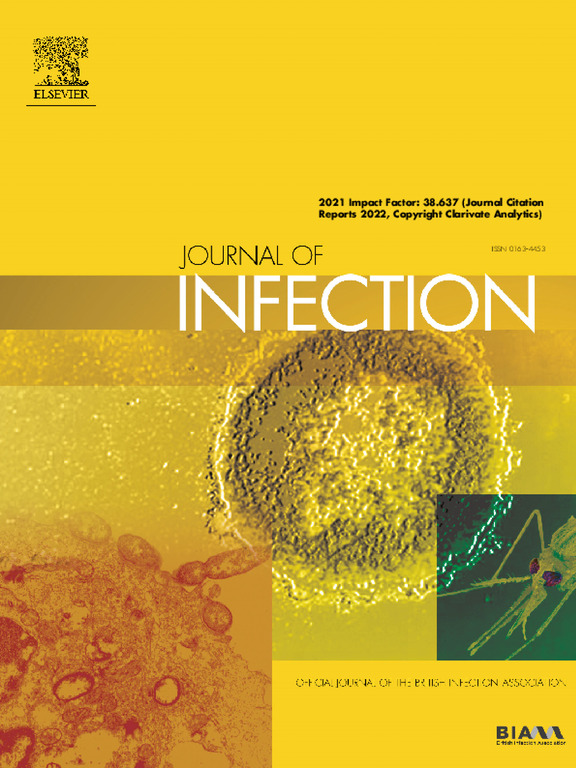耐碳青霉烯大肠埃希菌对头孢地罗的高流行率:来自中国多中心临床数据的警告
IF 11.9
1区 医学
Q1 INFECTIOUS DISEASES
引用次数: 0
摘要
目的:评价头孢地罗等药物对耐碳青霉烯型大肠杆菌(CREC)临床分离株的体外疗效,探讨头孢地罗耐药的遗传机制。方法:从全国27家三级医院收集638株非重复的CREC分离株。采用琼脂稀释法和肉汤微量稀释法测定抗菌药物的最低抑菌浓度(mic)。采用全基因组测序和生物信息学分析鉴定耐药基因和突变。基因敲除、互补和CRISPR-Cas9编辑用于验证耐药机制。结果:对16种抗菌药物进行了体外抑菌活性试验。其中替加环素的抗菌活性最高(100%),其次是多粘菌素B(95.9%)。然而,只有82人。5%的菌株对头孢地罗敏感,其MIC90最高可达128mg/L。99株头孢醚耐药大肠埃希菌中以ST167最为常见。超过90%的头孢地罗耐药分离株在cirA中存在突变或破坏,其中功能验证证实cirA失活,结合NDM表达,显著增加头孢地罗mic。其他耐药机制包括blaCMY-2过表达和ftsI突变。结论:Cefiderocol对中国大多数CREC分离株具有良好的活性;然而,显著比例的耐药正在出现,特别是在产生ndm的CirA缺失的无性系中。本文章由计算机程序翻译,如有差异,请以英文原文为准。
High prevalence of cefiderocol resistance in carbapenem-resistant Escherichia coli: A warning from multicenter clinical data in China
Aims
This study aimed to evaluate the in vitro efficacy of cefiderocol and other agents against carbapenem-resistant Escherichia coli (CREC) clinical isolates in China and to elucidate the genetic mechanisms underlying cefiderocol resistance.
Methods
A total of 638 non-duplicated CREC isolates were collected from 27 tertiary hospitals across China. Minimum inhibitory concentrations (MICs) of antimicrobial agents were determined by using agar dilution and broth microdilution methods. Whole-genome sequencing and bioinformatics analyses were conducted to identify resistance genes and mutations. Gene knockout, complementation, and CRISPR-Cas9 editing were used to validate resistance mechanisms.
Results
In vitro activity testing was conducted on 16 antimicrobial agents against all CREC isolates. Among these agents, tigecycline exhibited the highest antibacterial activity (100%), followed by polymyxin B (95.9%). However, only 82.5% of the strains were susceptible to cefiderocol, and its MIC90 reached as high as >128 mg/L. Among 99 cefiderocol-resistant Escherichia coli isolates, ST167 was the most prevalent. Over 90% of cefiderocol-resistant isolates harbored mutations or disruptions in cirA, in which functional validation confirmed that cirA inactivation, combined with NDM expression, significantly increased cefiderocol MICs. Additional resistance mechanisms included blaCMY-2 overexpression and ftsI mutations.
Conclusions
Cefiderocol shows promising activity against most CREC isolates in China; however, a notable proportion of resistance is emerging, particularly among NDM-producing clones with CirA loss.
求助全文
通过发布文献求助,成功后即可免费获取论文全文。
去求助
来源期刊

Journal of Infection
医学-传染病学
CiteScore
45.90
自引率
3.20%
发文量
475
审稿时长
16 days
期刊介绍:
The Journal of Infection publishes original papers on all aspects of infection - clinical, microbiological and epidemiological. The Journal seeks to bring together knowledge from all specialties involved in infection research and clinical practice, and present the best work in the ever-changing field of infection.
Each issue brings you Editorials that describe current or controversial topics of interest, high quality Reviews to keep you in touch with the latest developments in specific fields of interest, an Epidemiology section reporting studies in the hospital and the general community, and a lively correspondence section.
 求助内容:
求助内容: 应助结果提醒方式:
应助结果提醒方式:


